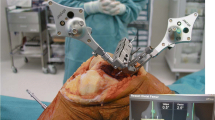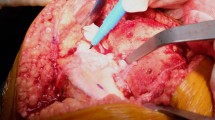Abstract
Background
Computer-aided surgery aims to improve implant alignment in TKA but has only been adopted by a minority for routine use. A novel approach, navigated freehand bone cutting (NFC), is intended to achieve wider acceptance by eliminating the need for cumbersome, implant-specific mechanical jigs and avoiding the expense of navigation.
Questions/Purposes
We determined cutting time, surface quality, implant fit, and implant alignment after NFC of synthetic femoral specimens and the feasibility and alignment of a complete TKA performed with NFC technology in cadaveric specimens.
Methods
Seven surgeons prepared six synthetic femoral specimens each, using our custom NFC system. Cutting times, quality of bone cuts, and implant fit and alignment were assessed quantitatively by CT surface scanning and computational measurements. Additionally, a single surgeon performed a complete TKA on two cadaveric specimens using the NFC system, with cutting time and implant alignment analyzed through plain radiographs and CT.
Results
For the synthetic specimens, femoral coronal alignment was within ± 2° of neutral in 94% of the specimens. Sagittal alignment was within 0° to 5° of flexion in all specimens. Rotation was within ± 1° of the epicondylar axis in 97% of the specimens. The mean time to make cuts improved from 13 minutes for the first specimen to 9 minutes for the fourth specimen. TKA was performed in two cadaveric specimens without complications and implants were well aligned.
Conclusions
TKA is feasible with NFC, which eliminates the need for implant-specific instruments. We observed a fast learning curve.
Clinical Relevance
NFC has the potential to improve TKA alignment, reduce operative time, and reduce the number of instruments in surgery. Fewer instruments and less sterilization could reduce costs associated with TKA.







Similar content being viewed by others
References
Barrera OA, Haider H, Garvin KL. Towards a standard in assessment of bone cutting for total knee replacement. Proc Inst Mech Eng H. 2008;222:63–74.
Bathis H, Perlick L, Tingart M, Luring C, Zurakowski D, Grifka J. Alignment in total knee arthroplasty: a comparison of computer-assisted surgery with the conventional technique. J Bone Joint Surg Br. 2004;86:682–687.
Bauwens K, Matthes G, Wich M, Gebhard F, Hanson B, Ekkernkamp A, Stengel D. Navigated total knee replacement: a meta-analysis. J Bone Joint Surg Am. 2007;89:261–269.
Berger RA, Crossett LS, Jacobs JJ, Rubash HE. Malrotation causing patellofemoral complications after total knee arthroplasty. Clin Orthop Relat Res. 1998;356:144–153.
Chauhan SK, Scott RG, Breidahl W, Beaver RJ. Computer-assisted knee arthroplasty versus a conventional jig-based technique: a randomised, prospective trial. J Bone Joint Surg Br. 2004;86:372–377.
Decking R, Markmann Y, Fuchs J, Puhl W, Scharf HP. Leg axis after computer-navigated total knee arthroplasty: a prospective randomized trial comparing computer-navigated and manual implantation. J Arthroplasty. 2005;20:282–288.
Haider H, Barrera OA, Garvin KL. Minimally invasive total knee arthroplasty surgery through navigated freehand bone cutting: winner of the 2005 “Hap” Paul Award. J Arthroplasty. 2007;22:535–542.
Harvie P, Sloan K, Beaver RJ. Three-dimensional component alignment and functional outcome in computer-navigated total knee arthroplasty: a prospective, randomized study comparing two navigation systems. J Arthroplasty. 2011;26:1285–1290.
Jeffery RS, Morris RW, Denham RA. Coronal alignment after total knee replacement. J Bone Joint Surg Br. 1991;73:709–714.
Mason JB, Fehring TK, Estok R, Banel D, Fahrbach K. Meta-analysis of alignment outcomes in computer-assisted total knee arthroplasty surgery. J Arthroplasty. 2007;22:1097–1106.
Matziolis G, Krocker D, Weiss U, Tohtz S, Perka C. A prospective, randomized study of computer-assisted and conventional total knee arthroplasty: three-dimensional evaluation of implant alignment and rotation. J Bone Joint Surg Am. 2007;89:236–243.
Mihalko WM, Saleh KJ, Krackow KA, Whiteside LA. Soft-tissue balancing during total knee arthroplasty in the varus knee. J Am Acad Orthop Surg. 2009;17:766–774.
Molli RG, Anderson KC, Buehler KC, Markel DC. Computer-assisted navigation software advancements improve the accuracy of total knee arthroplasty. J Arthroplasty. 2011;26:432–438.
Parratte S, Pagnano MW, Trousdale RT, Berry DJ. Effect of postoperative mechanical axis alignment on the fifteen-year survival of modern, cemented total knee replacements. J Bone Joint Surg Am. 2010;92:2143–2149.
Rand JA, Coventry MB. Ten-year evaluation of geometric total knee arthroplasty. Clin Orthop Relat Res. 1988;232:168–173.
Ritter MA, Davis KE, Meding JB, Pierson JL, Berend ME, Malinzak RA. The effect of alignment and BMI on failure of total knee replacement. J Bone Joint Surg Am. 2011;93:1588–1596.
Ritter MA, Faris PM, Keating EM, Meding JB. Postoperative alignment of total knee replacement: its effect on survival. Clin Orthop Relat Res. 1994;299:153–156.
Zhang GQ, Chen JY, Chai W, Liu M, Wang Y. Comparison between computer-assisted-navigation and conventional total knee arthroplasties in patients undergoing simultaneous bilateral procedures: a randomized clinical trial. J Bone Joint Surg Am. 2011;93:1190–1196.
Acknowledgments
Implants and instruments for this study were donated or loaned by DePuy Orthopaedics Inc and Exactech Inc. The authors thank the following surgeons for kindly acting as the subjects, performing the mock surgeries in the study (shown here in alphabetical order and unrelated in any way to any order shown for the results, which were deliberately kept secret): Jack Farr, MD; Pat Kirk, MD; Craig R. Mahoney, MD; Sandeep Munjal, MD; Amar Ranawat, MD; Chit Ranawat, MD; and Steve Teeny, MD.
Author information
Authors and Affiliations
Corresponding author
Additional information
The institution of four authors (KLG, AB, CWH, HH) has received, during the study period, funding from DePuy Orthopaedics Inc (Warsaw, IN, USA) and contract research funding from Arthrex Inc (Naples, FL, USA), Biomet Inc (Warsaw, IN, USA), Naval Health Research Center (San Diego, CA, USA), Empirical Testing Corp (Colorado Springs, CO, USA), Exactech Inc (Gainesville, FL, USA), Exponent Inc (Philadelphia, PA, USA), ESKA (Lübeck, Germany), Gruppo Bioimpianti (Milan, Italy), Kyocera Medical Corp (Osaka, Japan), Implanet (Martillac, France), Ortho Development (Draper, UT, USA), Otis Glebe Medical Research Foundation (Omaha, NE, USA), Renovis Surgical Technologies (Redlands, CA, USA), Smith & Nephew Inc (Memphis, TN, USA), SoftJoint (Iowa City, IA, USA), Stryker Orthopaedics (Mahwah, NJ, USA), Spine Medica (Atlanta, GA, USA), and Tornier (Montbonnot, France). The institution of one of the authors (CRM) has received, during the study period, funding from Smith & Nephew. One of the authors (KLG) certifies that he, or a member of his immediate family, has received or may receive payments or benefits, during the study period, an amount of $100,001 to $1,000,000 from Biomet Inc. One of the authors (HH) certifies that he, or a member of his immediate family, has received or may receive payments or benefits, during the study period, an amount of $10,000 to $100,000 from AMTI (Watertown, MA, USA), an amount of less than $10,000 from Arthrex, an amount of $10,000 to $100,000 from Biomet Inc, an amount of less than $10,000 from Orthopedic Surgical Manufacturers Association (Rockville, MD, USA), an amount of less than $10,000 from SoftJoint, and an amount of less than $10,000 from SI-BONE (San Jose, CA, USA).
All ICMJE Conflict of Interest Forms for authors and Clinical Orthopaedics and Related Research editors and board members are on file with the publication and can be viewed on request.
Each author certifies that his or her institution approved or waived approval for the human protocol for this investigation and that all investigations were conducted in conformity with ethical principles of research.
This work was performed at the Orthopaedics Biomechanics & Advanced Surgical Technologies Laboratory, University of Nebraska Medical Center, Omaha, NE, USA.
About this article
Cite this article
Garvin, K.L., Barrera, A., Mahoney, C.R. et al. Total Knee Arthroplasty With a Computer-navigated Saw: A Pilot Study. Clin Orthop Relat Res 471, 155–161 (2013). https://doi.org/10.1007/s11999-012-2521-2
Published:
Issue Date:
DOI: https://doi.org/10.1007/s11999-012-2521-2




